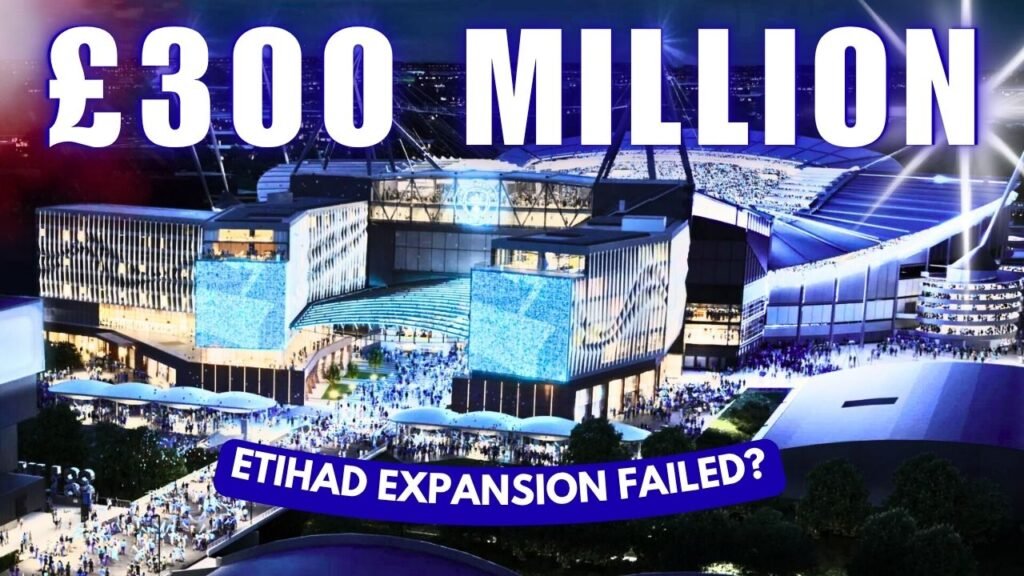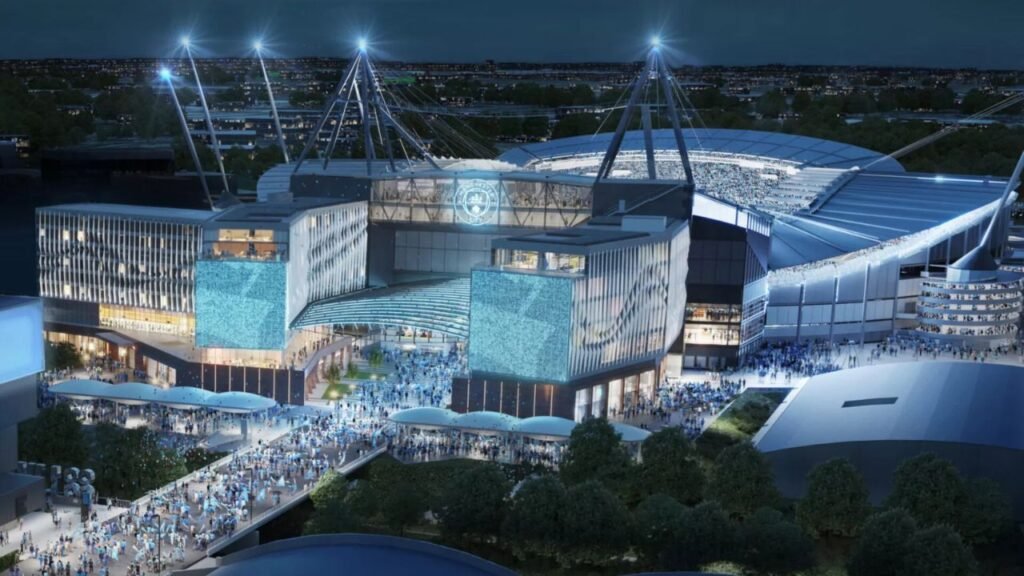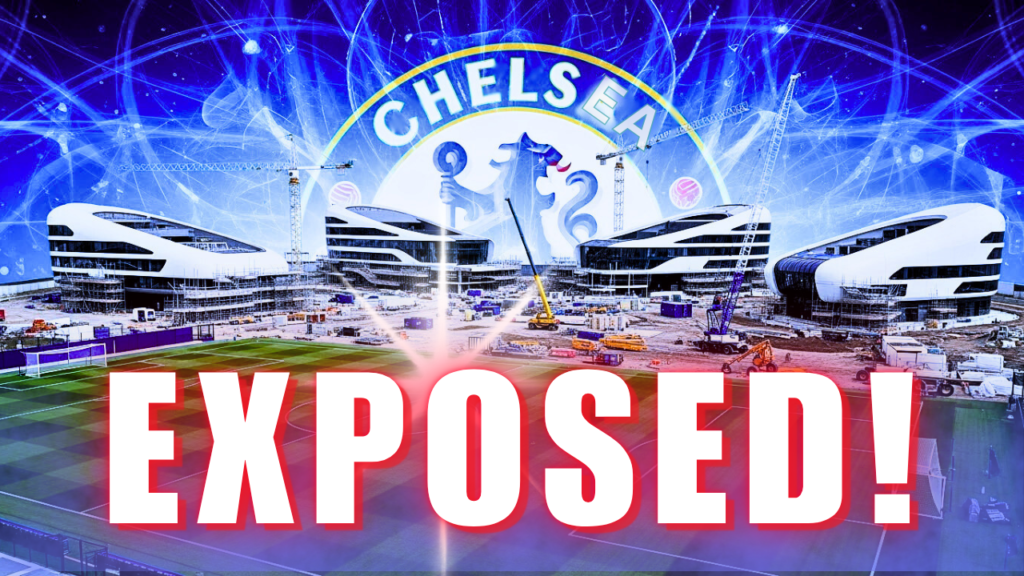Right now, cranes are lifting the final pieces of steel into place at the Etihad Stadium. Manchester City is betting £300 million on their future. A hotel. A museum. Over 7,000 new seats. But here’s the question nobody’s asking…
What happens if this doesn’t work? What if the vision City fans have been dreaming about… becomes football’s most expensive mistake?
Today, we’re exposing the FOUR trigger points that could derail everything. But here’s the thing – stick with me till the end, because what I’m about to reveal will change how you see this entire project.
Let me paint you a picture of what’s actually being built right now at the Etihad.
This isn’t just about making the stadium bigger. City is creating a 400-bed hotel with a rooftop Sky Bar overlooking the pitch. A covered fan zone for 3,000 people where you can arrive hours before kickoff. A museum that will finally give City’s incredible history the showcase it deserves. And yes – over 7,000 additional seats pushing capacity past 61,000.
The contractor Sisk installed the final structural beam back in May 2025, marking the highest point of construction. The new seating in the North Stand is scheduled to open during the 2025/26 season, with the complete entertainment complex ready by late 2026.
But here’s what makes this truly revolutionary: Most football stadiums sit empty over 340 days a year. Dead. Silent. Generating zero revenue. City is saying “absolutely not” to that model. They’re building a year-round entertainment destination. Concerts. Events. Museum visitors. Hotel guests. Seven days a week, 365 days a year. This place will be ALIVE.
It’s ambitious. It’s bold. It’s exactly what the world’s best clubs should be doing.
But if you’re a City fan, you’ve probably felt that little knot in your stomach asking: “What if something goes wrong?” So let’s go there. Because the only way to truly appreciate what City is building… is to understand what’s at stake if it doesn’t work.

The Attendance Question.
Okay, before anyone clicks away – I need you to hear me out on this one. I’m about to show you some numbers that might seem counterintuitive. But understanding THIS is crucial to understanding why City’s strategy is actually brilliant.
Here’s the reality: In the 2023/24 season, City boasted a phenomenal 99.7% occupancy rate for Premier League games. The demand is there. But here’s the challenge: the season ticket waiting list is reportedly over 120,000 people. The current stadium is full, but the club needs to prove it can fill a much bigger one, particularly for non-premium fixtures.
And it’s not just league games. Champions League matches against smaller European clubs? We’ve seen attendance dip below 50,000 in the past. That’s a visible 5,000+ empty seats for EUROPEAN FOOTBALL.
Now, if you’re a City fan, here’s what’s running through your head right now:
“What happens to ticket prices?” When you’ve got more supply than guaranteed demand, clubs face a brutal choice: lower prices and hurt revenue, or maintain prices and have cameras showing empty seats on every broadcast. Neither option is good when you’re servicing debt on a £300 million investment.
But here’s where it gets interesting… City isn’t stupid. They’ve seen these numbers. They KNOW about the attendance challenges. And you know what they’ve done? They’ve built the SOLUTION directly into the expansion.
Ringfenced tickets for fans aged 21 and under – creating pathways for the next generation. Rail seating sections designed specifically to boost atmosphere and bring back that authentic terrace experience. Breakout spaces, religious rooms, alcohol-free areas – they’re thinking about EVERY type of fan. This isn’t a club hoping attendance magically improves. This is a club engineering a solution.
The FFP Verdict.
Let’s talk about the elephant that’s been sitting in the room for two years now.
115 charges. The hearing wrapped up in December 2024. The verdict? Could literally drop ANY. DAY. NOW (especially with speculation focusing on October 2025).
And look, I’m not here to debate guilt or innocence – that’s for the independent commission. But as a City fan watching £300 million being poured into construction RIGHT NOW, you HAVE to game out the scenarios.
So let’s do exactly that.
Worst case: Significant points deduction or transfer ban hits mid-expansion. Construction can’t stop – it’s too far along. But suddenly you’ve got reduced matchday revenue because fans aren’t showing up when you’re mid-table. Sponsors get nervous, renegotiate deals downward. Hotel bookings crater because people aren’t traveling for matches anymore. The financial pressure becomes absolutely crushing.
Best case: Complete exoneration or minor penalties. The cloud lifts. The expansion opens right as City enters a new era of financial certainty. That £300 million suddenly looks like perfect timing, perfect vision.
But here’s what you need to understand – and this is CRITICAL:
Roel de Vries, City Football Group’s Chief Operating Officer, has specifically framed this as “a year-round entertainment destination” that creates “lasting long-term economic and social benefits for our local community.”
They’re building infrastructure that has value BEYOND Saturday at 3pm. Even if on-pitch performance dips temporarily – and let’s be honest, eventually it will when Pep leaves – a hotel is still a hotel. A museum is still a museum. A fan zone still hosts events.
City’s ownership has ALWAYS played the long game. Always. This expansion is just the latest move in that chess match.
The Competition Reality.
Here’s something that might surprise you: City isn’t the only club making massive moves right now.
Once this expansion completes, the Etihad becomes England’s fourth-largest club stadium at over 61,000 capacity. Sounds impressive until you realize what everyone ELSE is planning.
United is exploring potential stadium redevelopment toward 100,000 capacity. One. Hundred. Thousand. That’s direct competition for tourist fans, corporate hospitality, and global brand dominance. Arsenal is looking at taking the Emirates beyond 60,000 toward 70,000. Newcastle is debating a 60 to 70,000 seat project. Liverpool just finished their Anfield expansion.
Eight out of 20 Premier League clubs are planning major expansions. Everyone. Is. Building.
And right next door to the Etihad? The 23,500-capacity Co-op Live arena hosting concerts and entertainment events. That’s competition for YOUR entertainment pound on non-matchdays.
But hold on – because this is where the story gets really interesting.
Liverpool’s Anfield renovation added £23 million in annual income. Tottenham’s new stadium generates a reported £120 million annually from premium hospitality alone. The data is screaming something at us: Stadium investment WORKS when executed properly.
City’s expansion isn’t happening because they’re scared of competition. It’s happening because they see the same gold mine everyone else sees… and they’re betting they can execute it better than anyone.
The Generational Challenge.
Look, I’m going to be straight with you because this deserves honesty.
City’s modern dominance has been incredible. The treble. Sustained excellence under Pep Guardiola. But in the grand timeline of football history, that success is… relatively recent. And that creates a legitimate question: What happens when the success slows down?
Here’s the thing about clubs like Liverpool and United – when THEY have down periods, three generations of families still show up. That connection runs deeper than current results. City is building that NOW. The fanbase is growing massively, especially among younger supporters who’ve only ever known City as champions. But deep, multi-generational loyalty? That takes time.
And let’s be honest about something else: Pep Guardiola is a massive draw. When he eventually moves on, there WILL be a transition period. How does that affect ticket demand?
Now here’s why this should actually make you feel BETTER, not worse:
City is specifically building mechanisms to create LASTING support. Those ringfenced tickets for under-21s? That’s not charity – that’s strategy. They’re creating affordable pathways for your kids, for the next generation, ensuring that in 2045, those kids are bringing THEIR kids to the Etihad. The museum isn’t just a tourist attraction – it’s a way to cement City’s story into Manchester’s cultural fabric.
City’s success has given them the financial runway to make these investments NOW. They’re not waiting until they’re desperate. They’re building from a position of strength.
The Optimistic Reality

Okay, we’ve looked at all the trigger points. All the ways this COULD go sideways. Now let’s talk about how this actually goes RIGHT.
Here’s what the data ACTUALLY shows:
The market is THERE. The demand is REAL. Stadium expansions consistently deliver higher capacities and enhanced matchday revenues that reduce dependence on broadcasting and sponsorship income. City is building MULTIPLE revenue streams that work together:
- More seats equals more ticket revenue – but not just any tickets. Premium hospitality that rival anything in Europe. Rail seating sections that will create a wall of noise rivaling Dortmund’s Yellow Wall.
- A 400-bed hotel generating income 365 days a year.
- A museum that becomes a must-visit Manchester attraction.
And here’s what often gets overlooked: The completed development brings hundreds of new full-time and part-time jobs to East Manchester. This isn’t just about City. It’s about Beswick, Bradford, Clayton – the communities that have been there through everything.
This isn’t just about capacity. It’s about creating an experience worthy of the football you’re watching.
And THAT’S why this works…
So here’s where we land after analyzing every trigger point, every risk, every concern:
Yes, the challenges are real. FFP uncertainty? Absolutely valid. Competition? Intense. But you know what else is real? The track record.
When City Football Group took over in 2008, they built a training complex that’s the envy of world football. They built a system that other clubs now study. This expansion is just the next chapter in that story.
And here’s what the FANS are saying: Feedback from Manchester City supporters has been overwhelmingly positive, with most seeing this as exactly the step the club needs to maintain dominance while creating infrastructure for the future.
I believe – and I genuinely mean this – that in 2027, we’re going to look back at this moment and wonder why we ever doubted. We’ll see those packed stands with rail seating creating atmosphere that gives visiting teams nightmares. We’ll see families bringing kids to the museum on random Tuesdays, creating the next generation of supporters. We’ll see the hotel driving economic growth in communities that deserve it.
So what if Man City’s £300 million Etihad Stadium expansion fails?
Here’s my honest answer: It won’t.
Because failure would require City to stop being City. It would require them to abandon the long-term thinking that’s defined every major decision since 2008. It would require fans to stop caring. And none of that is happening.
This expansion represents ambition, vision, and a commitment to building something that outlasts all of us. And if you’re a City fan, you should be incredibly excited.
What do YOU think? Are you excited? Nervous? Both? Drop your thoughts in the comments – I genuinely want to hear from City supporters about what this means to you.


